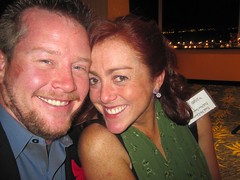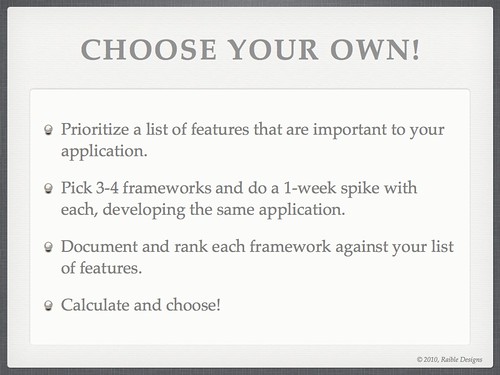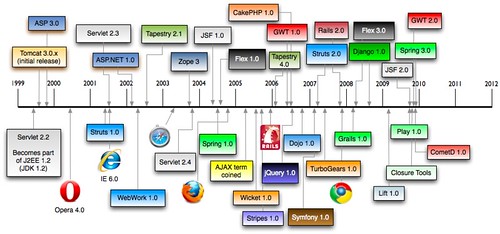2010 was a heckuva year, possibly one of my all-time favorites. It started with lots of anticipated fun and ended with lots of travel, skiing and relaxing and I'm only just now finding time to write this post. I had a lot of goals when I started 2010; the top two being my favorite:
The rest of my goals involved running, skiing, mountain biking and finishing The Bus. I also had some professional goals that involved open source, conferences, publishing articles and learning new technologies. I accomplished about 75% of my personal goals and 50% of my professional goals. I'm pretty happy with these percentages considering how much fun I had last year.
In December 2009, I started working with Time Warner Cable as their Chief Architect of Web Development. I was hired to help them build a team of hard-working developers that could quickly build their online video presence. In January, we started getting our ducks in a row with some Agile Training in Virginia, followed by hiring some Agile Coaches. The only technical post I had during this process was about development infrastructure stacks. Both at TWC and my current gig, I've found myself enjoying the following stack:
- Source Control: SVN
- Source Viewer: FishEye
- Wiki: Confluence
- Bug Tracker: JIRA
- Continuous Integration: Hudson
We tried Git for a couple months at TWC, but ended up reverting to SVN after we had "code deleted" issues during one of our most intense development cycles. When the kids and I weren't skiing, we worked on documenting How to be a Super Hero and The Adventures of Upside Down Man.
In February, I refreshed my Grails knowledge, later learning that it was tough to teach Grails to developers that didn't know Java. First of all, a lot of Grails and Groovy books are targeted at Java Developers. Secondly, the developers I was trying to sell it to had more interest in learning Java. Since I failed to sell Grails, we ended up using Spring + jQuery to build our app. I don't think was a bad decision as most of our development ended up being UI: ActionScript/Flex, Objective-C and jQuery/HTML.
My laptop was stolen from my living room in early February. It worked out nicely in the end since I didn't lose any data (thanks to good backups) and my business insurance covered the loss. My parents came out and helped me finish remodeling my guest room. I posted about My Future of Web Frameworks Presentations and became a proud father when "Jack was flying past both Abbie and I and giggling while doing it".
By the beginning of March, we'd hired a team of 10 at TWC and I took a trip to Jackson Hole to celebrate.
The thing I enjoyed the most about this trip was how well the group jelled. Kudos to Chris for assembling such an awesome group and putting such a spectacular trip together. Can't wait for next year.

The next week, I flew to Las Vegas for The ServerSide Java Symposium and enjoyed sessions on Cloud, Web Service APIs, Flex, Spring 3 and Cameron's Lessons Learned from the Internet Age. I posted my Future of Web Frameworks and GWT vs. Flex Smackdown presentations after the conference.
I ended March with The Trifecta.




For Easter, I purchased an iPad and reviewed it a few days later. Seven months later, I'm not enthralled with the iPad, but I do think it's a heckuva lot better than the Galaxy Tab. I don't use it much, except for movies when traveling. My kids are its primary users, mostly using it for games and Netflix.
We visited my parents in Oregon and celebrated my Mom's retirement.




The picture I took of my Mom and Abbie that weekend is one of my all-time favorites.
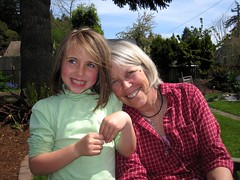
At the end of April, I said farewell to the ski season, getting in 25 days; a personal best. I'm happy to report I have 10 days in so far this year, so my goal of 30 days looks to be well on track. No helicopter attempts yet, but hopefully soon.
I ended the month with a work trip to Seattle and painting the town red with my sister and Mya.




I returned to Denver and turned off my TV for a month. I wrote about my experience in early June. For Memorial Day Weekend, I went mountain biking in Moab and had a blast at the Desert Rocks Music Festival. The Porcupine Rim ride took us 4.5 hours and we tracked 26.75 miles. The several points in the trail with "death on the right" were truly epic.




June started with our annual Ride to Red Rocks. I slept six hours and did the 25-mile off-road Elephant Rock ride the next morning. The next morning I hopped on a plane to Ireland for the Irish Software Show. My sister joined me and we had an incredible time with Jamie, Rob, John and Josh.




Upon returning to work, I got to have an awkward conversation with my client about all the vacation I was taking.
 For Father's Day, my parents drove to Denver and we packed up the camping gear for a fun weekend at The Great Sand Dunes.
After The Dunes, my parents and kids drove to The Cabin, camping out and touring Yellowstone along the way. That Thursday, June 24th, I attended my good friend Jason's birthday party in Lodo.
For Father's Day, my parents drove to Denver and we packed up the camping gear for a fun weekend at The Great Sand Dunes.
After The Dunes, my parents and kids drove to The Cabin, camping out and touring Yellowstone along the way. That Thursday, June 24th, I attended my good friend Jason's birthday party in Lodo.
That's the night I met Trish.
I saw her switch from a Martini to a Guinness and I knew I had to talk to her. I introduced myself and quickly found myself conflicted with having a soon-to-expire iPhone 4 reservation at the Apple Store. I rushed out to grab the phone, returning because there was something special about Trish. We talked for a couple hours that night ... me mesmerized, her smiling a lot. I was dumbfounded to find such a cool person existed in the world. At the end of the night, I got her number and drove home with a feeling that my life was about to change.
The next day, I began a road trip to The Last Best Place for a Montana Summer Vacation.




During that trip, Trish and I exchanged occasional text messages and I told many friends about the kick-ass girl I met. It was another great Montana vacation.
My favorite part of this year's trip to The Cabin was seeing it as a home again. My Mom retired in April and my parents moved back to Montana shortly after. Seeing how happy they are there is truly magical. I especially enjoy the thought of visiting them and all the wonderful folks in the Swan Valley many, many times in the future.
The kids and I drove like bats out of hell and made it back to Denver (950 miles) in 14.25 hours. I quickly scheduled a first date with Trish that Wednesday, and went back to work at TWC with a renewed energy. After our first date, I formed a sort of perma-grin. That Friday was my birthday. I've been having a blast with Trish ever since.
July ended with a trip to the Lost Coast for Jess and Lili's Wedding.
The reception afterwards was a truly spectacular party that lasted well into the evening. Clint and I vowed to go to bed early, but we ended up having so much fun we closed the place down. Jess and Lili were an instrumental part in creating a spectacular night, especially with their wedding dance and infectious happiness.
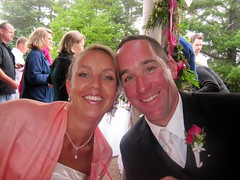
In August, I celebrated this blog's 8th birthday and we started our "60-Day Push" at work. The goal of our 60-Day Push was to re-write our Video Portal, iPad and Sony Blu-ray apps from scratch, without politics dictating their features. We hired Method for design, chose our own features and went to work. I wrote about the success of this effort in October.
I neglected to write about the Denver Cruisers Saints and Sinners ride or how much fun we had listening to B.B. King at Red Rocks.
Abbie and Jack's first day of school was on August 16th.

At the end of August, we celebrated Jack's 6th Birthday and attended my Cousin Amy's Wedding in Missouri.






September rolled in, we finished the majority of the work in our 60-Day Push and Trish and I drove up to Estes Park for an epic weekend at the Scottish-Irish Festival. We rode our bikes in the parade (by accident), enjoyed a few pints and even did a bit of fly-fishing near our riverside accommodations.




We listened to the 1st 2010 Broncos game while driving back from Estes and slipped into a Rockies game shortly after losing. Our sadness over the Broncos loss was erased within a couple hours as we celebrated Jason Giambi's walk-off home run. Unfortunately, the Rockies didn't make it to the post-season, but the Broncos looked good at their home opener.

October came quickly and I wrote How's the ol' Team Doing and defended the Age of Frameworks. At the end of October, we moved into TWC's Lodo Office on Wynkoop. That weekend, we dressed up as superheros for Halloween.
November started off with Abbie's birthday and Trish got to meet the kids for the first time. From there, we went into traveling-like-madmen mode. We enjoyed suite seats at the Broncos vs. Kansas City game, then flew to Amsterdam for Devoxx the next morning (performing an AppFuse release along the way). I presented on Thursday and posted my Comparing JVM Web Frameworks presentation shortly after. I wrote about our trip while at The Cabin for Thanksgiving.




I flew back from Montana, stopped in at the Lodo office for a couple days, then hopped on a plane to the Rich Web Experience with Trish. My presentations went well, sparked some controversy, and we raced to Key West to celebrate the end of the conference season.




I returned to Denver for my last week at TWC, enjoyed a couple days of skiing, then headed to Utah for an interview with Overstock.com. While I enjoyed my time at TWC, my contract duration was up and being a full-time employee didn't give me the vacation time I tend to enjoy. My interview with Overstock.com was two days, with the 2nd day on the slopes at Snowbird. I was very impressed by the company, people and interview process and agreed to work there on the way to the airport.
I returned to Denver for Trish's Birthday Weekend at Breckenridge, then flew down to Naples on Wednesday to spend Christmas with her family. It was my first time meeting her parents, but that didn't stop us from having a great time talking, beach-going, golfing and relaxing.




We returned to Denver, I tried to get AppFuse 2.1 finished and then we celebrated New Years with friends in Steamboat.


As I reminisce about last year, I can't help but smile. While I've been a happy person for a while, having someone to share your life with is a special thing. I feel like I dreamed up Trish a couple years ago. I was looking for someone that liked to do my favorite activities: mountain biking, skiing, traveling the world and enjoying good beer. I found that and more in Trish and couldn't be happier.
I didn't write as many technical posts on this blog as I'd like to, but I attribute that mostly to the lack of learning new things at TWC. At Overstock.com, I expect that to change and hope to have more technical articles in the coming year.
At the end of last year's Year in Review, I wrote:
I hope to speak at (or attend) 3 conferences, finish up The Bus and do a whole bunch of skiing and mountain biking.
I accomplished all but one goal: finishing The Bus. In 2011, I plan on doing two main things: keep rockin' it with Trish and finishing The Bus. Everything else is gravy. 
It's gonna be a spectacular year.
